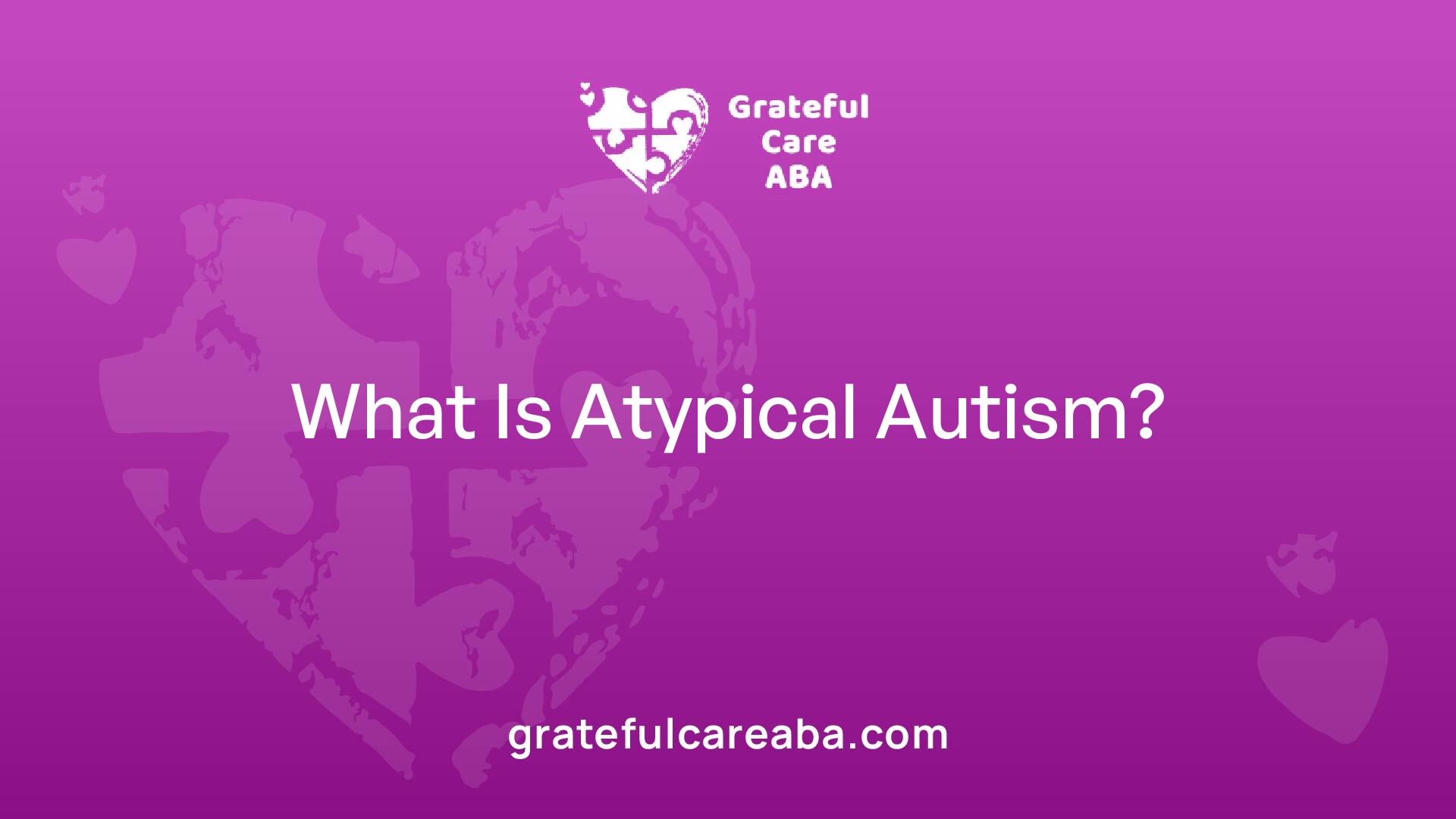What Is Atypical Autism?
Discover the nuances of atypical autism: defining characteristics, impacts, and personalized treatment for a unique journey.


Understanding Atypical Autism
Diving into the world of atypical autism also called pervasive developmental disorder-not otherwise specified (PDD-NOS)— isn't like reading the usual book on autism. It's a category for folks who show just some of the famous autism symptoms, not the full set.

Definition of Atypical Autism
So, what’s atypical autism all about? As Yellow Bus ABA puts it, this diagnosis is for people who don’t fit the classic autism mold. It's like being on the autism train but in the last car. Once known as PDD-NOS, these individuals have traits that echo autism but don’t tick all the boxes needed for an official autism spectrum disorder stamp.
Characteristics of Atypical Autism
Atypical autism often means milder symptoms than classic autism, according to Yellow Bus ABA. People here might have a leg up on the social scene and can talk the talk better than those with textbook autism. But they still stumble over social signals and keeping friends can be tricky, echoing the broad reach of autism's spectrum.
Golden Care Therapy notes that those with atypical autism, or what some call autistic traits or subthreshold autism, might have much milder delays in thinking, growing, and socializing, with fewer of the typical autistic behaviors compared to the general autism crew.
Getting a grasp on atypical autism is key to offering the right kind of help. By seeing the special signs of atypical autism, care folks can whip up treatment plans that fit like a glove, serving what each individual truly needs.
Diagnosing Atypical Autism
Figuring out if someone has atypical autism isn't your average doctor's appointment. You need an all-star healthcare team like a savvy psychiatrist, brainy psychologist, or the go-to developmental pediatrician. They roll out the big guns for a deep dive into behavior quirks, chit-chat skills, and how our star interacts with their buddies. It's all about nailing down those traits that scream 'atypical autism'.
Evaluation by Healthcare Professional
The spotlight first shines on the healthcare pro who’s seeing beyond typical tantrums and silent stares. They don’t just wing it—they arm themselves with chats with parents, boss-level observations across various settings, and tests that dig up backstories and current vibes of the person in question. It’s all groundwork for a full-on understanding of what's ticking—or not.
Diagnostic Criteria for Atypical Autism
Depending on whether they're flipping open the DSM-5 or ICD-11, the rules for calling it atypical autism can switch up just a smidge. Zooming in on DSM-5—an autism diagnosis hinges on two sticky wickets: fumbles in social chit-chatty areas and repetitive behaviors that could make anyone dizzy. And the clock's ticking from early childhood for these traits to really stick [1].
Differentiation from Typical Autism
In the heyday of the DSM-IV, folks with what we'd now call atypical autism, tagged as PDD-NOS or subthreshold autism, were just living in the shadows of classic autism traits. Think of them as the milder version—perhaps managing without anyone holding their hand too tightly or skirting closer to what some might label 'high-functioning'.
Once DSM-5 rolled out in 2013, autism wasn’t just repping a fractured identity but got a crisp new look—a one-stop-shop under autism spectrum disorder (ASD). This isn't just admin fluff. It's about capturing the big picture and catering to everyone from the barely-there quirks to those making everyday things a Herculean task [1].
Grasping what's what between atypical and typical autism isn’t just for shrinks' fun day out. It’s about laying down the right paths for support so every individual with autism, no matter their spot on the spectrum, gets a fair shake at life.
Prevalence and Impact of Atypical Autism
Digging into how common atypical autism is, and what it means for those dealing with it, sheds light on how often it pops up and how it affects getting along and chatting with others.
Frequency of Atypical Autism
Once tagged as pervasive developmental disorder not otherwise specified (PDD-NOS), atypical autism was a label for kids showing some, but not all, autism traits. As we got smarter about autism, PDD-NOS and atypical autism got the boot, replaced by the catch-all autism spectrum disorder (ASD) in 2013 with the "Diagnostic and Statistical Manual of Mental Disorders, Fifth Edition" (DSM-5).
Atypical autism isn’t as common as the regular kind, hovering around 5-10% of those with an ASD label. So while it’s not the big fish in the autism pond, it’s still worth paying attention to.
Impact on Social and Communication Skills
Folks with atypical autism show a softer side of symptoms compared to standard autism. They might be better at social stuff and chit-chat than those with full-blown autism, but they can still trip up on picking up social vibes or keeping friendships afloat. This shows how crucial it is to have custom help that fits the bill for them.
Also in the mix is virtual autism, where someone shows autism-like traits but doesn’t check all the boxes for an official diagnosis. The jury's still out on whether these traits can be dialed back or corrected.
Grasping the prevalence and effects of atypical autism is key for tailored help and support. By acknowledging both the hiccups and the hidden talents of those with atypical autism, health pros and families can better their lives and help them shine.
Treatment Approaches for Atypical Autism
When it comes to supporting folks with atypical autism, it's all about using multiple strategies. Their needs are unique, and the challenges aren't small. The aim's to get in there early with a mix of behavioral and supportive therapies to boost their development and help them enjoy life a bit more.
Early Intervention Importance
Catching signs of atypical autism early can make a world of difference. Pinning things down in preschool or even sooner means kids can get the right kind of help when it matters most. According to the NICHD, getting ahead of the curve with early intervention can lead to a big payoff in how symptoms show up and how skills grow. These programs cover a bunch of fun activities and learning tailored to fit what each little one needs.
Behavioral Therapies
Think of behavioral therapies as the backbone of atypical autism treatment. They're all about tackling tricky behaviors, boosting the way kids talk, and helping them learn to make friends. One well-known strategy is Applied Behavior Analysis (ABA), which is basically a way to turn positive behavior into a winning habit. This approach is about building bridges in communication, making it easier to chat with others, and just dealing with life's everyday stuff better.
On top of that, there's Occupational Therapy (OT) and Physical Therapy (PT), which play a major part in treatment. OT is like a superhero for sensory issues and those pesky motor skills, teaching kids life skills with a focus on fine-tuning those smaller movements [2]. PT, on the other hand, works on the bigger picture like helping improve coordination and balance, making sure kids can take part in everyday activities.
Supportive Therapies
Sometimes, kiddos with atypical autism need a bit more, and that's where supportive therapies come in. As of now, no meds are officially given a thumbs-up for the core bits of atypical autism. But you might see some prescriptions dealing with behavior issues like irritability and aggression. If meds are in the mix, it's super important that a health professional is keeping watch, making sure everything's on track.
By mixing early help with behavioral therapies and the extra support where needed, we get a full picture of care for kids with atypical autism. Treatment plans shaped by healthcare experts aim to give them the tools for a better life, helping them take on challenges with a splash of confidence and independence.
Atypical Autism vs. Other Autism Forms
Figuring out different types of autism is like piecing together a puzzle. It's crucial to know what sets atypical autism apart from other kinds. Here, we’ll dive into how atypical autism compares to classic autism, point out what makes virtual autism unique, and look at the hurdles folks with atypical autism face.
Comparison with Classic Autism
Classic autism, the kind most folks have at least heard of, follows a set checklist from the DSM-5. People with this kind often seem socially distant and have a penchant for patterns and routines.
Atypical autism, on the other hand, doesn't follow the playbook. Its symptoms come in a wider variety, showing up in some expected ways and some not-so-expected ones, making diagnosis like finding a needle in a haystack and treatment a bit like a game of whack-a-mole.
Virtual Autism Distinctions
Virtual autism might sound like something from a tech fair, but it’s all about the many faces of autism. It’s a catch-all phrase to describe those who don't fit neatly into any one category. Atypical autism? That’s under this wider net, capturing the broad mix of symptoms that step outside the norm [4].
This idea highlights that everyone on the autism spectrum is a unique puzzle, needing a personalized approach, a kind of custom-made strategy that suits them best.
Unique Challenges of Atypical Autism
Atypical autism brings with it a unique mix of puzzles. The way symptoms appear can be all over the map, plus they might come bundled with extra features, making it tricky to pin down exactly what’s going on and how best to help.
People dealing with atypical autism might experience unusual reactions to sensory inputs, struggle with communication, or have particular behavioral quirks. This variety means you must use a broad brushstroke approach to help them.
Tackling the special needs tied to atypical autism requires a team effort—think psychologists, speech therapists, and occupational therapists all coming together like the Avengers to craft care plans that play to their strengths and meet their needs. By understanding what makes atypical autism tick, we can better focus on giving them the right kind of support to improve their daily lives and overall happiness.
Evolution of Autism Diagnosis
The evolution of how we diagnose autism spectrum disorders (ASD) has come quite a ways, especially with updates from the DSM-IV to the DSM-5. These leaps aren't just about numbers on a page; they've really reshaped our understanding of autism and how we classify it.
Changes from DSM-IV to DSM-5
In 2013, the American Psychiatric Association (APA) came out with the DSM-5. It's like they switched up the playbook for diagnosing autism. The new edition said it's all about spotting ongoing struggles with social interactions and communication. So, to get an autism diagnosis under the DSM-5, folks need to show issues with social give-and-take, non-verbal cues, and relationships in different settings [3].
Clarifications in DSM-5-TR
Fast forward to 2022, and the APA tweaked things even more with the DSM-5 Text Revision (DSM-5-TR). One little change that makes a big difference was swapping "manifested by the following" to "as manifested by all of the following." Why does this matter? Well, it's all about making the guidelines crystal clear so that everyone's on the same page when assessing ASD.
Importance of Refinement
Making sure diagnostic criteria are on point matters big time for spotting atypical autism early. These symptoms, though they might show up during early development, sometimes only become really obvious when the pressure's on or if people have found ways to hide them as they grow older. What's key is that these symptoms should mess with social life, work, or other vital life parts [3].
Also, the DSM-5 makes it clear: those signs of atypical autism shouldn't be brushed off as just a result of intellectual issues or overall development delays. If someone has trouble socially but doesn't tick all the ASD boxes, they should be checked out for social (pragmatic) communication disorder for a spot-on diagnosis and the right help.
As we keep refining how we diagnose autism, we're not just ticking boxes. We're getting better at really seeing these complex disorders and offering sharper identification and help tailored to folks with atypical autism.
Atypical Autism: Past vs. Present
Taking a trip down memory lane to explore the history of atypical autism, it's crazy to see how its story has totally transformed and where it stands today in the world of autism diagnosis. Once upon a time, this quirky cousin of classic autism was known by a fancier term: pervasive developmental disorder not otherwise specified, or PDD-NOS if you like acronyms.
Previously Known as PDD-NOS
Back in the day, doctors slapped the PDD-NOS label on kiddos who kind of fit the autism mold but didn't tick all the boxes. This was the label for the oddballs, those who danced to the beat of their own drum and twisted the typical image of autism just enough not to get the regular tag.
Transition to ASD Diagnosis
The big shake-up came in 2013 with the updated DSM-5—that’s the Diagnostic and Statistical Manual of Mental Disorders, not that anybody remembers what it stands for. This was a game changer. Poof! The old subtypes, including PDD-NOS, got swept into the new, shiny "Autism Spectrum Disorder" or ASD. Now, everyone who navigates the autism maze sits under one big rooftop category, this made the old term PDD-NOS be put on the shelf to collect dust.
Continuity of Symptoms
But here's the kicker—even though the labels were retired, folks who sported the atypical or PDD-NOS badge still wave the same flag when it comes to symptoms. Sure, they got a new label, but the old quirks didn't pack their bags and leave. So, these distinct characteristics persist, showing that the challenges faced by these individuals have stuck around, no matter what you call them.
From past oddity to mainstream: that's the tale of atypical autism evolving into the framework of ASD. This makes you think about how crucial it is to keep testing and tweaking our understanding to give everybody, regardless of where they sit on the spectrum, the support they need today and tomorrow.
Personalized Care for Atypical Autism
People with atypical autism often get a better shake with care that's all about their own jam and what they need help with. The real magic involves treatment plans that fit just right, having healthcare folks in your corner, and ideas to make life a bit more awesome.
Tailored Treatment Plans
Crafting treatment plans that are just for them is a big deal for those with atypical autism. These plans are unique - like a custom-made suit. They hone in on polishing social chops, smoothing out tricky behaviors, and boosting life's quality. Occupational therapy (OT) and physical therapy (PT) are like anchors in a storm: they help sharpen those sensory, motor, and daily action skills one step at a time.
Treatment Approach What Does It Do?
- Occupational Therapy: Focuses on daily tasks and fine motor skills.
- Physical Therapy: Enhances gross motor skills, balance, and coordination.
Giving these therapies a personal touch really makes a difference in how folks with atypical autism grow and navigate everyday life.
Healthcare Professional Support
Having healthcare pros in your corner is like having a top-notch pit crew for folks with atypical autism and their families. These pros - be it doctors, therapists or teachers - offer wisdom, guidance, and that little extra something to help handle atypical autism’s quirks. Spotting things early and getting the ball rolling with treatments can change the game in how well someone deals with symptoms and picks up new skills.
Sometimes, doctors might suggest meds to tame things like irritability or self-hurting behavior, but it's no silver bullet for autism's core pieces; tweaking and watching them closely is the name of the game.
Improving Quality of Life
Living a great life with atypical autism means juggling all parts of life - heart, mind, and social stuff. Getting those day-to-day skills down pat, making friends, and creating a space that's kind and caring can light up their world. Personalized treatment, professional backup, and individual care help folks with atypical autism find their groove and smash through what’s possible for them.
References
[2]: https://autismsciencefoundation.org/treatment-options/
[3]: https://www.autismspeaks.org/autism-diagnostic-criteria-dsm-5
[4]: https://webautism.com/classic-autism-vs-virtual-autism/
[5]: https://www.eccm.org/blog/fact-or-fiction-are-there-different-types-of-autism
[6]: https://goldencaretherapy.com/atypical-autism/
[7]: https://www.nichd.nih.gov/health/topics/autism/conditioninfo/treatments
Apply Now
At Grateful Care ABA, we are proud to offer the best ABA therapy services in Indiana. Armed with a team of skilled Board Certified Behavior Analysts (BCBAs), we bring years of experience to the table, making us the preferred provider for ABA therapy in our community.
Understanding that every child with ASD is unique and has unique goals and objectives, our ABA therapists carefully craft personalized ABA therapy plans that are tailored to meet the specific needs of each child. Whether your child needs help with reducing maladaptive behaviors, your child needs IEP support at school, you want your child to be self-sufficient at home, or something else, we use ABA therapy to work diligently toward specific goals. Together we can make a difference in your child’s life!
Contact us today to connect with an ABA therapist and learn more about ABA therapy solutions for your child.

































































































